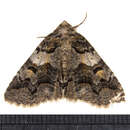Conservation Status
provided by University of Alberta Museums
A fairly common widespread species; no concerns.
- license
- cc-by-nc
- copyright
- University of Alberta Museums
Cyclicity
provided by University of Alberta Museums
In Alberta adults have been colleced in late May-June.
- license
- cc-by-nc
- copyright
- University of Alberta Museums
Distribution
provided by University of Alberta Museums
NS west across Canada to Vancouver Island; north to the mouth of the Skeena River in BC and the Lake Athabasca region in AB, south in the western mountains. Found throughout the foothills, mountains and boreal forest region (including the Cypress Hills) in Alberta, north to Colin-Cornwalll Wildland Park.
- license
- cc-by-nc
- copyright
- University of Alberta Museums
General Description
provided by University of Alberta Museums
A medium-size (3.4-3.6 cm wingspan) broad-winged powdery grey or grey-brown moth. The FW varies considerably, from a pale grey with dark brown-black basal, median and sub-terminal banding, to being more or less uniformly suffused with dark sooty brown scales. The ST line often has a dark red-brown outer edging, and there is a contrasting pale yellowish or buff lunule on the outer edge of the reniform in both forms. The HW is a dark yellow-brown, paler than the FW, crossed by a faint doubled basal band, a straight median line and a fine scalloped terminal line. The HW patterning is unusual in noctuid moths other than the genus Zale, and resembles certain Geometrids, such as Pero sp.. This little Zale is quite variable in appearance, but differs from other Alberta Zale in its sooty grey or light grey coloration (rich browns in the others). Alberta Z. duplicata belong to ssp. largera, which are larger and paler with more grey than black scaling than in the nominate subspecies.
- license
- cc-by-nc
- copyright
- University of Alberta Museums
Habitat
provided by University of Alberta Museums
Pine forest
- license
- cc-by-nc
- copyright
- University of Alberta Museums
Life Cycle
provided by University of Alberta Museums
There is a single annual brood, with adults flying in the spring. The larvae are solitary defoliators of pines. They overwinter in the pupal stage. The larvae (illustrated in color in Wong and Ives, 1988) are reported to be extremely variable in color, with forms ranging from grey, reddish brown to whitish with darker markings (Wong and Ives, 1988).
- license
- cc-by-nc
- copyright
- University of Alberta Museums
Trophic Strategy
provided by University of Alberta Museums
Pines (Pinus sp.), in particular Lodgepole (Pinus contorta) and Jackpine (P. banksiana). (Prentice, 1962).
- license
- cc-by-nc
- copyright
- University of Alberta Museums
Zale duplicata
provided by wikipedia EN
Zale duplicata, the pine false looper zale, pine false looper, banded similar-wing or grey similar-wing, is a moth of the family Noctuidae. The species was first described by Charles J. S. Bethune in 1865. It is found in woodlands and forests from British Columbia to Nova Scotia, south to the mountains of Georgia and Texas.
The wingspan is 34–36 mm. Adults are on wing from late May to June in Alberta. There is one generation per year.
The larvae feed on eastern white pine from New Brunswick to North Carolina. North and westward it is reported to on various other pines, including both hard (two- and three-needled species) and soft pines (usually five-needled species). The larvae of ssp. largera feed on jack pine exclusively.
Subspecies
- Zale duplicata duplicata
-
Zale duplicata largera (J. B. Smith, 1908)

- license
- cc-by-sa-3.0
- copyright
- Wikipedia authors and editors
Zale duplicata: Brief Summary
provided by wikipedia EN
Zale duplicata, the pine false looper zale, pine false looper, banded similar-wing or grey similar-wing, is a moth of the family Noctuidae. The species was first described by Charles J. S. Bethune in 1865. It is found in woodlands and forests from British Columbia to Nova Scotia, south to the mountains of Georgia and Texas.
The wingspan is 34–36 mm. Adults are on wing from late May to June in Alberta. There is one generation per year.
The larvae feed on eastern white pine from New Brunswick to North Carolina. North and westward it is reported to on various other pines, including both hard (two- and three-needled species) and soft pines (usually five-needled species). The larvae of ssp. largera feed on jack pine exclusively.
- license
- cc-by-sa-3.0
- copyright
- Wikipedia authors and editors

